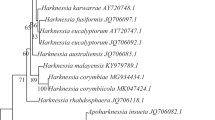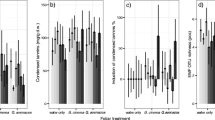Abstract
Eucalyptus marginata is the dominant tree of a forest community in south-western Australia. It is susceptible to infection by Phytophthora cinnamomi and is usually rare on long-infested sites. Ex situ stem inoculation was used to compare the susceptibility of E. marginata plants in long-infested sites and adjoining uninfested sites. Plants were found to be less susceptible on some long-infested sites but other factors may also be important in regulating regeneration and survival of E. marginata.
Similar content being viewed by others
References
Department of Conservation and Land Management (2003) ‘Phytophthora cinnamomi and disease caused by it. Vol. 1. Management Guidelines.’ (Department of Conservation and Land Management: Como, Western Australia).
Hüberli D, Tommerup IC, Dobrowolski MP, Calver MC, Hardy GEStJ (2001) Phenotypic variation in a clonal lineage of two Phytophthora cinnamomi populations from Western Australia. Mycological Research 105, 1053–1064.
Hüberli D, Tommerup IC, Colquhoun IJ, Hardy GEStJ (2002a) Evaluation of resistance to Phytophthora cinnamomi in seed-grown trees and clonal lines of Eucalyptus marginata inoculated in lateral branches and roots. Plant Pathology 51, 435–442. doi: 10.1046/j.1365-3059.2002.00728.x
Hüberli D, Tommerup IC, Calver MC, Colquhoun IJ, Hardy GEStJ (2002b) Temperature and inoculation method influence disease phenotypes and mortality of Eucalyptus marginata clonal lines inoculated with Phytophthora cinnamomi. Australasian Plant Pathology 31, 107–118. doi: 10.1071/AP01078
Malajczuk N (1979) Biological suppression of Phytophthora cinnamomi in eucalypts and avocado in Australia. In ‘Soil-borne plant pathogens’. (Eds B Schippers, W Gams) pp. 635–652. (Academic Press: London)
McComb JA, Bennett IJ, Stukely MJC, Crane C (1991) Selection and propagation of jarrah for dieback resistance. Combined Proceedings of the International Plant Propagator’s Society 40, 86–90.
McDougall KL (1997) Vegetation patterns in the northern jarrah forest of Western Australia in relation to dieback history and the current distribution of Phytophthora cinnamomi. PhD Thesis, Murdoch University, Western Australia.
McDougall KL, Hobbs RJ, Hardy GEStJ (2002a) Floristic and structural differences between Phytophthora infested and adjoining uninfested vegetation in the northern jarrah (Eucalyptus marginata) forest of Western Australia. Australian Journal of Botany 50, 277–288. doi: 10.1071/BT01096
McDougall KL, Hardy GEStJ, Hobbs RJ (2002b) The distribution of Phytophthora cinnamomi in the northern jarrah (Eucalyptus marginata) forest of Western Australia in relation to dieback age and topography. Australian Journal of Botany 50, 107–114. doi: 10.1071/BT01040
McDougall KL, Summerell BA (2003) The impact of Phytophthora cinnamomi on the flora and vegetation of New South Wales — a re-appraisal. In ‘Phytophthora in Forests and Natural Ecosystems. 2nd International IUFRO Working Party 7.02.09 Meeting, Albany, Western Australia, October 2001’. (Eds JA McComb, GEStJ Hardy, IC Tommerup) pp. 49–56. (Murdoch University Print: Murdoch, Western Australia)
Shearer BL, Michaelson BJ, Warren HJ (1987) Comparative behaviour of Phytophthora species in secondary phloem of stems and excised roots of Banksia grandis and Eucalyptus marginata. Australian Journal of Botany 35, 103–110. doi: 10.1071/BT9870103
Sochacki SJ (1982) A comparative study of four northern jarrah forest soil types in relation to Phytophthora cinnamomi Rands. Honours Thesis, Murdoch University, Western Australia.
Stukely MJC, Crane CE (1994) Genetically based resistance of Eucalyptus marginata to Phytophthora cinnamomi. Phytopathology 84, 650–656. doi: 10.1094/Phyto-84-650
Stukely MJC, Crane CE, McComb JA, Bennett IJ (2007) Field survival and growth of clonal, micropropagated Eucalyptus marginata selected for resistance to Phytophthora cinnamomi. Forest Ecology and Management 238, 330–334. doi: 10.1016/j.foreco.2006.10.028
Tippett JT, Hill TC, Shearer BL (1985) Resistance of Eucalyptus spp. to invasion by Phytophthora cinnamomi. Australian Journal of Botany 33, 409–418. doi: 10.1071/BT9850409
Weste G, Kennedy J (1997) Regeneration of susceptible native species following a decline of Phytophthora cinnamomi over a period of 20 years on defined plots in the Grampians, western Victoria. Australian Journal of Botany 45, 167–190. doi: 10.1071/BT96048
Weste G, Walchhuetter T, Walshe T (1999) Regeneration of Xanthorrhoea australis following epidemic disease due to Phytophthora cinnamomi in the Brisbane Ranges, Victoria. Australasian Plant Pathology 28, 162–169. doi: 10.1071/AP99027
Author information
Authors and Affiliations
Corresponding author
Rights and permissions
About this article
Cite this article
McDougall, K.L., Hardy, G.E.S.J. & Hobbs, R.J. Comparison of colonisation by Phytophthora cinnamomi in detached stem tissue of Eucalyptus marginata in relation to site disease status. Australasian Plant Pathology 36, 498–500 (2007). https://doi.org/10.1071/AP07056
Received:
Accepted:
Issue Date:
DOI: https://doi.org/10.1071/AP07056




